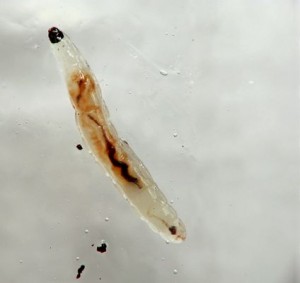Insects that damage the African violet: Mushroom musculita (Sciaridae)
 These insects are known to every violet lover. Some small flies flying over the flower pots. Sometimes they disappear, sometimes they fly by the hundreds around the plants in the room.
These insects are known to every violet lover. Some small flies flying over the flower pots. Sometimes they disappear, sometimes they fly by the hundreds around the plants in the room.
Fungus mosquitoes from the Sciaridae family are spread all over the world, but at the same time they remain the least studied group of the two-winged insect order Diptera.
Sciarids are living fossils, being one of the oldest groups of dipteran insects. Due to its small size and isolated larval phase, sciaridele for a long time did not attract anyone's attention. Currently, the family in question counts over 1700 species studied.
Amateurs of African violets meet with representatives of three species: sciara, Lycoriella and Bradysia. Without a microscope, it is useless to distinguish between them.
In pots with plants, sciarids reach either with the soil substrate, either from outside, laying eggs in the moist soil in the pots.
Getting rid of mushroom flies once and for all is impossible. If there are feeding and propagating conditions, they will stop again and again at your flowers.
The excess hydration of the soil and the high content of decaying organic matter are the ideal conditions for the multiplication of sciarides.
Sciarid is a 0.5-2 mm sized fly with a narrow body and round head. Body color may differ depending on the species, but usually it is gray or black. The 'oral' organs of the adult whitefly are poorly developed. The wings of many species of sciarids are well developed, but there are also species without wings.
Adult insects do not feed and of course do not harm plants.
The female lays her eggs in moist and slightly acidic soil. After about a week, from the eggs come out larvae of size 2-10 mm. Larvae of sciarids have no legs, are semitransparent, have translucent intestine and large head of black color. They can leave a slimy trail above the ground, barely visible. If the larvae of sciarids were taken from wet soil, they would die in a few minutes. Therefore, they do not support a dry soil.
African violets mature, mushroom bites can not harm them in any way. Instead the larvae are the enemy to be feared. They feed on decaying soil organic matter, attacking at the same time the roots of plants. If the plants are grown under normal conditions and the cultivation techniques are applied correctly, the lesions caused by the larvae at the level of the root system are minor and are compensated by the growth of new roots. In the case of mass reproduction of sciarides, larvae actively feed on the living tissues of the plant. Some species of flies for example, Cucumber fly (Bradysia brunnipes Mg.) and the greenhouse fly (Plastosciosa perniciosa Edv) adore the roots and parts of the plant that touch the ground, damaging the seedlings.
Species of sciarids from pots in apartments, houses do not seriously damage the plants.
Fight with sciaridele, podura and root lice proves to be a work of Sisyphus. These insects will appear more often in our pots.
When mushroom bites are by the hundreds, and their larvae are easily noticeable as they move through the soil, they become a real problem.
In combating sciarides, of real use is the shredded shell of coconuts, if added to the soil composition. The plant will get wet as the soil dries out. Avoid soil substrates that have in their composition non-decomposed organic matter (remnants of dried plants).
Good results we get then, when in the water with which we water the plant we will add Citramon or Ascofen (half a pill per 3-4 l of water) or glutamate permanganate (a few bobites, until the water is colored in light pink).
If the number of sciarids does not shrink, resort to the use of an insecticide, for example: DIMILIN 25 WP (is incorporated into compost 4,0 g/sqm or 40 g/m3), Actara, Mospilan, Dantop (it is enough that the soil in the pots to be watered with a solution from one of these insecticides. It is recommended no more than 3 chemical treatments at intervals of 7-10 days).
In the case of planting African violets, to avoid infestation of the soil with such specimens, the soil will be stopped or heat treated. The seeds will be planted in hermetically sealed pots.


I had the plants and I